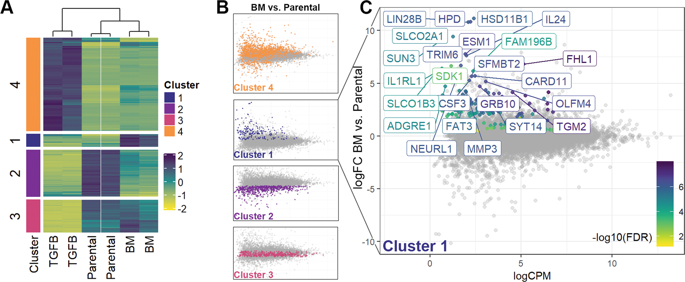当前位置:
X-MOL 学术
›
Oncogenesis
›
论文详情
Our official English website, www.x-mol.net, welcomes your feedback! (Note: you will need to create a separate account there.)
Transglutaminase-2 facilitates extracellular vesicle-mediated establishment of the metastatic niche.
Oncogenesis ( IF 6.2 ) Pub Date : 2020-02-13 , DOI: 10.1038/s41389-020-0204-5 Aparna Shinde 1 , Juan Sebastian Paez 1 , Sarah Libring 2 , Kelsey Hopkins 2 , Luis Solorio 2, 3 , Michael K Wendt 1, 3
Oncogenesis ( IF 6.2 ) Pub Date : 2020-02-13 , DOI: 10.1038/s41389-020-0204-5 Aparna Shinde 1 , Juan Sebastian Paez 1 , Sarah Libring 2 , Kelsey Hopkins 2 , Luis Solorio 2, 3 , Michael K Wendt 1, 3
Affiliation

|
The ability of breast cancer cells to interconvert between epithelial and mesenchymal states contributes to their metastatic potential. As opposed to cell autonomous effects, the impact of epithelial-mesenchymal plasticity (EMP) on primary and metastatic tumor microenvironments remains poorly characterized. Herein we utilize global gene expression analyses to characterize a metastatic model of EMP as compared to their non-metastatic counterparts. Using this approach, we demonstrate that upregulation of the extracellular matrix crosslinking enzyme tissue transglutaminase-2 (TG2) is part of a novel gene signature that only emerges in metastatic cells that have undergone induction and reversion of epithelial-mesenchymal transition (EMT). Consistent with our model system, patient survival is diminished when primary tumors demonstrate enhanced levels of TG2 in conjunction with its substrate, fibronectin. Targeted depletion of TG2 inhibits metastasis, while overexpression of TG2 is sufficient to enhance this process. In addition to being present within cells, we demonstrate a robust increase in the amount of TG2 and crosslinked fibronectin present within extracellular vesicle (EV) fractions derived from metastatic breast cancer cells. Confocal microscopy of these EVs suggests that FN undergoes fibrillogenesis on their surface via a TG2 and Tensin1-dependent process. Upon in vivo administration, the ability of tumor-derived EVs to induce metastatic niche formation and enhance subsequent pulmonary tumor growth requires the presence and activity of TG2. Finally, we develop a novel 3D model of the metastatic niche to demonstrate that conditioning of pulmonary fibroblasts via pretreatment with tumor-derived EVs promotes subsequent growth of breast cancer cells in a TG2-dependent fashion. Overall, our studies illustrate a novel mechanism through which EMP contributes to metastatic niche development and distant metastasis via tumor-derived EVs containing aberrant levels of TG2 and fibrillar FN.
中文翻译:

转谷氨酰胺酶2促进细胞外囊泡介导的转移利基的建立。
乳腺癌细胞在上皮状态和间质状态之间相互转换的能力有助于其转移潜力。与细胞自主作用相反,上皮-间充质可塑性(EMP)对原发性和转移性肿瘤微环境的影响仍然很差。在这里,我们利用全局基因表达分析来表征与非转移性对应物相比的EMP转移模型。使用这种方法,我们证明细胞外基质交联酶组织转谷氨酰胺酶2(TG2)的上调是一种新的基因签名的一部分,该新签名仅出现在经历上皮-间质转化(EMT)诱导和逆转的转移性细胞中。与我们的模型系统一致,当原发肿瘤显示TG2及其底物纤连蛋白水平升高时,患者的生存率就会降低。TG2的靶向耗竭抑制了转移,而TG2的过表达足以增强这一过程。除了存在于细胞内外,我们还证明了源自转移性乳腺癌细胞的细胞外囊泡(EV)组分中存在的TG2和交联的纤连蛋白的含量强劲增加。这些电动车的共聚焦显微镜表明,FN通过TG2和Tensin1依赖性过程在其表面发生原纤维形成。在体内给药后,肿瘤来源的电动汽车诱导转移性小生境形成并增强随后的肺部肿瘤生长的能力需要TG2的存在和活性。最后,我们开发了转移性小生境的新型3D模型,以证明通过用肿瘤衍生的EV进行预处理来调节肺成纤维细胞,可以以TG2依赖性的方式促进乳腺癌细胞的后续生长。总体而言,我们的研究表明,EMP通过包含异常水平的TG2和原纤维FN的肿瘤源性EV促进转移性小生境发展和远处转移。
更新日期:2020-02-13
中文翻译:

转谷氨酰胺酶2促进细胞外囊泡介导的转移利基的建立。
乳腺癌细胞在上皮状态和间质状态之间相互转换的能力有助于其转移潜力。与细胞自主作用相反,上皮-间充质可塑性(EMP)对原发性和转移性肿瘤微环境的影响仍然很差。在这里,我们利用全局基因表达分析来表征与非转移性对应物相比的EMP转移模型。使用这种方法,我们证明细胞外基质交联酶组织转谷氨酰胺酶2(TG2)的上调是一种新的基因签名的一部分,该新签名仅出现在经历上皮-间质转化(EMT)诱导和逆转的转移性细胞中。与我们的模型系统一致,当原发肿瘤显示TG2及其底物纤连蛋白水平升高时,患者的生存率就会降低。TG2的靶向耗竭抑制了转移,而TG2的过表达足以增强这一过程。除了存在于细胞内外,我们还证明了源自转移性乳腺癌细胞的细胞外囊泡(EV)组分中存在的TG2和交联的纤连蛋白的含量强劲增加。这些电动车的共聚焦显微镜表明,FN通过TG2和Tensin1依赖性过程在其表面发生原纤维形成。在体内给药后,肿瘤来源的电动汽车诱导转移性小生境形成并增强随后的肺部肿瘤生长的能力需要TG2的存在和活性。最后,我们开发了转移性小生境的新型3D模型,以证明通过用肿瘤衍生的EV进行预处理来调节肺成纤维细胞,可以以TG2依赖性的方式促进乳腺癌细胞的后续生长。总体而言,我们的研究表明,EMP通过包含异常水平的TG2和原纤维FN的肿瘤源性EV促进转移性小生境发展和远处转移。


























 京公网安备 11010802027423号
京公网安备 11010802027423号